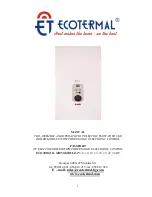
66
Radijator Inženjering d.o.o, 36000 Kraljevo, Živojina Lazića
- Solunca br.6, Srbija
tel. +381 36 399 140, fax. +381 36 399 150, http://www.radijator.rs
e-mail: [email protected]
3.3.2 Working space and positioning of BIO
lux
UNI 20
When determining where to place boiler pay attention to the following details:
Boiler must be as close to the chimney as possible, also supply of fresh air for
combustion should be close.
The unit must never be installed in a bedroom or a room that is impossible to separate
from bedroom by the door
The room in which BIO
lux
UNI 20 is installed another heating unit can not be used,
such as a stove ora fireplace, solid fuel and pelet heating units. Necessary circulation of
air through one of these devices is likely to be oppressed by the air supply to the other
unit.
The room in which the boiler is positioned must be able to let the ventilation and
connectivity with fresh air or with a room that is connected to external fresh air. This
connection is made with non-combustible steel pipes.
For the operation of the unit the power supply of 230 V and 50 Hz is needed. Place the
boiler as close to the connection socket as possible and on this occasion avoid extension
cords.
In case of setting the boiler on the combustible surfaces (floors, laminates, rugs, carpets,
etc.). It is necessary to insulate the unit from such substrates with a plate of
uncombustible materials (steel, ceramics, insulation materials, ceramic fiber, etc.). Such
plates should be sized as to be larger from the base of the boiler (see Figure 8.2).
Boiler must be at a safe distance from flammable materials such as wood and textile,
pieces of furniture, curtains, plastic parts etc. The distance must be at least one meter
from such materials.
Distance of the boiler from the solid immovable objects (walls, columns, etc.)
(Figure 8.2) laterally must be at least 40 cm (Figure 8.2 measures B), at the back of
40 cm (Figure 8.2 measures C) and at the front of 100 cm (Fig. 8.2 A measures). This
gap distances are necessary because of approaching to hole for cleaning as well as
for access during service interventions.















































